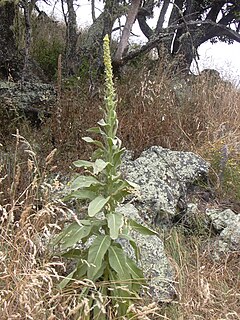
Verbascum thapsus, the great mullein, greater mullein or common mullein is a species of mullein native to Europe, northern Africa, and Asia, and introduced in the Americas and Australia.
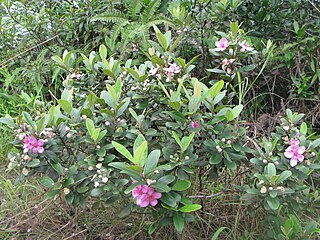
Rhodomyrtus tomentosa also known as rose myrtle, is a flowering plant in the family Myrtaceae, native to southern and southeastern Asia, from India, east to southern China, Hong Kong, Taiwan and the Philippines, and south to Malaysia and Sulawesi. It grows in coasts, natural forest, riparian zones, wetlands, moist and wet forests, bog margins, from sea level up to 2400 m elevation.

Packera obovata, the roundleaf ragwort or spoon-leaved ragwort, is an erect perennial herb native to Eastern North America. It was previously called Senecio obovatus. Basal and lower leaves are obovate with toothed margins, while upper leaves are pinnately divided. The ray flowers are yellow and the disk flowers orange-yellow, the inflorescences being held well above the foliage.

Viola sororia, known commonly as the common blue violet, is a short-stemmed herbaceous perennial plant that is native to eastern North America. It is known by a number of common names, including common meadow violet, purple violet, woolly blue violet, hooded violet, and wood violet. Its cultivar 'Albiflora' has gained the Royal Horticultural Society's Award of Garden Merit. This perennial plant species is distributed in the eastern half of the United States, Canada and a part of Eastern Mexico. Their native habitats are rich, moist woods, and swamps located in the eastern half of the United States and Canada.

Prunus tomentosa is a species of Prunus native to northern and western China, Korea, Mongolia, and possibly northern India. Common names for Prunus tomentosa include Nanjing cherry, Korean cherry, Manchu cherry, downy cherry, Shanghai cherry, Ando cherry, mountain cherry, Chinese bush cherry, and Chinese dwarf cherry.
Packera bernardina is a rare species of flowering plant in the aster family known by the common name San Bernardino ragwort.
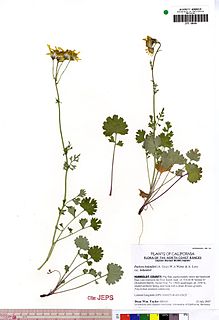
Packera bolanderi is a species of flowering plant in the aster family known by the common names Bolander's ragwort and seacoast ragwort. It is native to the west coast of the United States from Washington to northern California, where it grows in wet coastal forests and woodlands. There are two varieties of the species which differ slightly in morphology and habitat occupied; these varieties have been considered separate species by some authors. The var. bolanderi has thicker leaves, occurs farther south, and occupies more open types of habitat, than does var. harfordii. This plant in general is a perennial herb producing one to three stems up to half a meter tall. The basal leaves have blades up to 12 centimeters long which are divided into several lobes and borne on long, thin petioles. Leaves growing farther up the stem are smaller and have more lobes on their blades. The inflorescence contains several flower heads, each lined with dark green phyllaries. The head contains many golden yellow disc florets and generally either 8 or 13 yellow ray florets each over a centimeter long. The fruit is an achene tipped with a pappus of bristles.

Packera eurycephala is a species of flowering plant in the aster family known by the common name widehead groundsel. It is native to a section of the western United States encompassing southern Oregon, northern California, and northern Nevada. It can be found in dry habitat types, often in disturbed areas, and it favors serpentine soils.
Packera ganderi is a rare species of flowering plant in the aster family known by the common name Gander's ragwort. It is endemic to southern California, where it is known from a few occurrences in San Diego and Riverside Counties.
Packera ionophylla is an uncommon species of flowering plant in the aster family known by the common name Tehachapi ragwort. It is endemic to California, where it is known from the Tehachapi Mountains, the San Gabriel and San Bernardino Mountains, and Alamo Mountain near the Grapevine. It grows in mountain forest habitat.
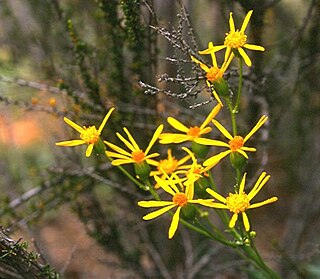
Packera layneae, known by the common name Layne's ragwort and Layne's butterweed, is a rare species of flowering plant in the aster family.

Packera multilobata is a species of flowering plant in the aster family known by the common name lobeleaf groundsel. It is native to the western United States from California to Wyoming to New Mexico, where it is common and can be found in many habitat types.

Packera streptanthifolia is a species of flowering plant in the aster family known by the common name Rocky Mountain groundsel. It is native to western North America from Alaska to California to New Mexico, where it can be found in mountain habitat including woodlands and rocky slopes.
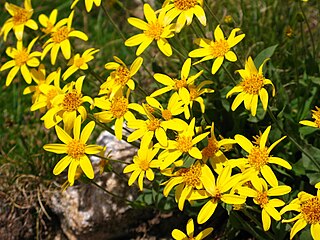
Packera werneriifolia, known by the common names alpine rock butterweed and hoary groundsel, is a species of flowering plant in the aster family. It is native to the western United States in the Sierra Nevada mountain habitat in subalpine and alpine climates, including forests and barren talus.

Sophora tomentosa, also known as necklacepod, yellow necklacepod, and occasionally as silver bush, is a pantropical shrub or small tree in the family Fabaceae. It commonly ranges in height from 4 to 10 feet and often occurs in coastal conditions and near wetlands. The common name Necklacepod is derived from the characteristic string of seed pods that develop after its yellow flowers germinate into seeds.
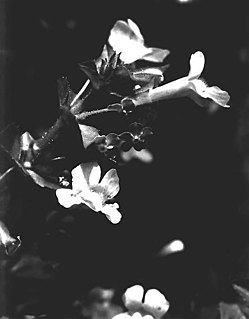
Erythranthe michiganensis is a rare species of flowering plant in the lopseed family, known by the common name Michigan monkeyflower. This species occurs only in the Grand Traverse and Mackinac Straits areas within the American state of Michigan. It is one of only three plant species that are endemic to Michigan, with the other two being Voss's Goldenrod and Packera insulae-regalis.
Packera castoreus is a rare species of flowering plant in the aster family known by the common names Beaver Mountain groundsel and Beaver Mountain ragwort. It is endemic to Utah in the United States, where it occurs only in the Tushar Mountains.
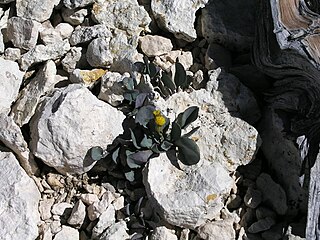
Packera malmstenii is a rare species of flowering plant in the aster family known by the common name Podunk ragwort. It is endemic to Utah in the United States, where there about 19 occurrences in the southwestern part of the state.

Packera musiniensis is a rare species of flowering plant in the aster family known by the common names Musinea ragwort and Musinea groundsel. It is endemic to Utah in the United States, where it is known only from Sanpete County in the Manti-La Sal National Forest.

Packera schweinitziana, commonly called New England groundsel, is a species of flowering plant in the aster family (Asteraceae). It is native to eastern North America, where it is primarily found in eastern Canada and the northeastern United States, with disjunct populations in North Carolina and Tennessee on Roan Mountain. Its natural habitat is in sunny, wet areas, often in acidic soil. In the southeastern United States, its habitat is restricted to Appalachian balds.
















